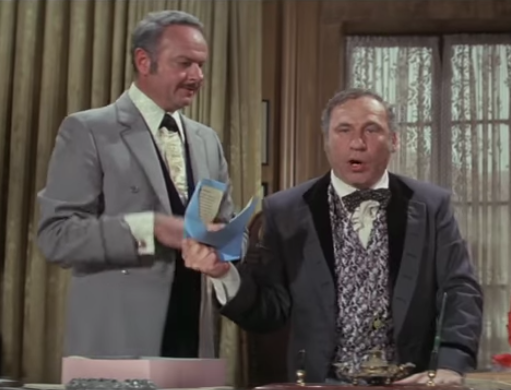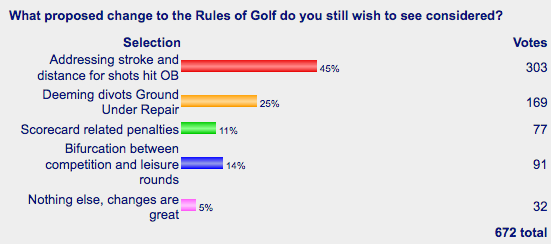These kids today? So cynical!
 I remember the good old days when the USGA and R&A would dump one of their heaping piles of horse manure on our laps and it would be me, a few architects and the late, great Frank Hannigan calling them out. Well, thankfully while I was busy chasing some fun stories around Riviera today, others gave away time they'll never get back in their lives to point out just how absurd our governing bodies' latest report appears.
I remember the good old days when the USGA and R&A would dump one of their heaping piles of horse manure on our laps and it would be me, a few architects and the late, great Frank Hannigan calling them out. Well, thankfully while I was busy chasing some fun stories around Riviera today, others gave away time they'll never get back in their lives to point out just how absurd our governing bodies' latest report appears.
Before we get there, For Immediate Release:
USGA and The R&A Publish Research on Driving Distance in Golf
FAR HILLS, N.J. and ST. ANDREWS, SCOTLAND (February 15, 2017) - The USGA and The R&A have published their annual review of driving distance, a research document that reports important findings on driving distance in golf.
Introduced last year, the review examines driving distance data from seven of the major professional golf tours, based on approximately 285,000 drives per year. Data from studies of male and female amateur golfers has also been included for the first time.
Key facts noted in the paper include:
Between 2003 and the end of the 2016 season, average driving distance on five of the seven tours has increased by approximately 1.2%, around 0.2 yards per year.
For the same time period, average driving distance on the other two tours studied decreased by approximately 1.5%.
Looking at all of the players who are ranked for distance on the PGA TOUR and PGA European Tour, the amount by which players are “long” or “short” has not changed – for instance, since 2003 the 10 shortest players in that group are about 6% shorter than average, while the 10 longest players in the group are about 7% longer than average. The statistics are not skewed toward either longer or shorter players.
The average launch conditions on the PGA TOUR – clubhead speed, launch angle, ball speed and ball backspin – have been relatively stable since 2007. The 90th-percentile clubhead speed coupled with the average launch angle and spin rate are very close to the conditions that The R&A and the USGA, golf’s governing bodies, use to test golf balls under the Overall Distance Standard.
Mike Davis, executive director/CEO of the USGA, said, “We appreciate the collaboration we have received, industry-wide, to access and review this data to benefit the entire golf community, which can be used to both educate golfers and advance the game.”
Martin Slumbers, chief executive of The R&A, said, “In the interests of good governance and transparency it is important that we continue to provide reliable data and facts about driving distance in golf.
“Driving distance remains a topic of discussion within the game and the review provides accurate data to help inform the debate.”
Furthermore, Governor William J. Lepotomane chimed in: "Gentleman, this study is the finest of its kind ever published!"
Now, I write to you from Riviera where, when I started hitting balls on the driving range tee in the late 80s, a 10-12 foot fence was in place. Then it went to 40 or so feet in the 90s, 80 feet in the 2000's and since 2012, for the PGA Tour's annual February visit, a special extension is added to raise the driving range fence to 120 feet.
The same fence extension will be needed this August when the U.S. Amateur comes to Riviera. Here's guessing the USGA would not appreciate an invoice to cover the cost of installing a temporary addition since, after all, today's report says recent distance gains are a figment of our imagination.
Reading today's report, GolfChannel.com's Will Gray writes more presciently than he probably realizes given that the USGA leans so hard on its outside PR firms to spin certain news:
As any PR firm can attest, statistics are a versatile tool. Choose the right data points, frame the right time period, and you can quantify support for nearly any argument. Such is the case with this study, the second in as many years released by the game’s governing bodies and one that simply continues to miss the point.
And I enjoyed this key point by Gray:
The study’s data focuses not on distance outliers, but instead on the large swath in the middle where, for the PGA Tour, the average drive reportedly lingers around 290 yards. But those top-end outliers have become increasingly noticeable in recent years as more and more marquee players launch towering drives.
A whopping 27 players cracked the 300-yard average last season on Tour, 15 more than the 2010 season and 18 more than in 2003. Individual drives over 300 yards, which made up just 26.56 percent of tee shots in 2003, accounted for 31.14 percent last season.
Then there’s Rory McIlroy tweeting out other-worldly Trackman data, Dustin Johnson bending Oakmont to his will and Henrik Stenson lifting the claret jug by relying not on his driver, but instead his trusty 3-wood.
And don’t forget about Ariya Jutanugarn, who powered her way to LPGA Player of the Year honors while barely touching her driver in 2016, mostly hitting 2-irons off the tee.
Those are data points that the study fails to address, although the findings insist that PGA Tour players hit driver on “measured” driving holes more than 95 percent of the time last year.
James Hahn even took to Twitter to agree:
Rex Hoggard talked to players and equipment reps at Riviera and noted the skepticism about the USGA/R&A launch conditions take.
According to multiple equipment representatives from various companies, the average golf ball spin for a driver on Tour is down about 500 rpm from ’03, while the average launch on drives is up between 2 and 4 degrees. Without getting lost in the science of the golf swing and new technology, lower spin and higher launch means more distance and it’s the players with the highest clubhead speed that enjoy the greatest benefit from this evolution.
Put another way, more clubhead speed is the byproduct of better athletes, not better equipment, and modern technology can be maximized for these players, which at least partially explains why the number of players averaging 300-plus yard drivers has tripled since 2003.
“You have kids like Justin Thomas who are using their bodies in ways that we weren’t taught and they swing for pure distance with their drivers,” said Johnson Wagner, who only half-jokingly refers to himself as a “dinosaur.”
“I think it’s working out, it’s launch monitors, it’s coaching. I don’t think it’s equipment; the clubs are what they are and have been for the last 10 years. It’s just everything and there’s nothing you can do.”
Oh don't be so sure!
 From Mike Stachura's report at the USGA Innovation Symposium in Vancouver:
From Mike Stachura's report at the USGA Innovation Symposium in Vancouver:





















